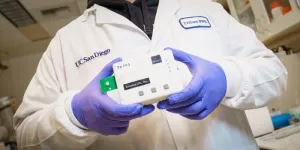(Press-News.org) Astrophysicist Jason Nordhaus is breaking cultural and disciplinary boundaries by helping to grow the number of deaf, hard-of-hearing, and Hispanic researchers. And, in doing so, he is enabling these future scientists to drive discoveries in one of his areas of expertise—neutron star astrophysics.
Nordhaus, an associate professor of physics at Rochester Institute of Technology’s National Technical Institute for the Deaf, has earned a National Science Foundation grant that connects NTID with Texas Tech University, a Hispanic Serving Institution. Through a series of unique summer research exchanges between the two universities, five promising undergraduates will study alongside the world’s astrophysics experts and Ph.D. candidates.
“This experience is designed to take teams of people from different universities that would naturally benefit from working with each other and bring them together,” said Nordhaus, who received the $313,000 grant with co-principal investigators Manuela Campanelli and Carlos Lousto, professors in RIT’s College of Science. All three are members of RIT’s Center for Computational Relativity and Gravitation. “At RIT, we have theorists and computational experts in the field of neutron stars, and Texas Tech has amazing scientists who are experts in data analysis and observations. Let’s get together and see what we can discover.”
The team’s area of expertise is neutron stars, extreme density objects that are produced from the collapse of a massive star. Neutron stars are born during the subsequent supernova explosion and can be difficult to detect as they age because they do not emit much light. Nordhaus’s research is based on learning their properties including their mass and spin rates, how they are accelerated to high speeds, whether they are magnetized, and how heavy elements in the universe, like gold, silver, platinum and lead, are formed when neutron stars merge.
“We are entering a golden age for studying neutron stars,” explained Nordhaus. “New observations leveraging electromagnetic, gravitational wave, and neutrino emission will provide unparalleled opportunities to answer fundamental questions in astrophysics. With a dream team composed of the world’s experts on neutron stars, we are pursuing research avenues that will drive new scientific discoveries.”
END
Astrophysicist uses NSF funding to grow the number of deaf, hard-of-hearing, and Hispanic researchers
Jason Nordhaus hopes to drive future discoveries by promising students
2023-11-13
ELSE PRESS RELEASES FROM THIS DATE:
A ‘fish cartel’ for Africa could benefit the countries, and their seas
2023-11-13
Banding together to sell fishing rights could generate economic benefits for African countries, which receive far less from access to their fisheries on the global market than other countries do from theirs. By joining forces, UC Santa Barbara researchers say in a paper published in the journal Nature Communications, African fisheries would not just secure more competitive access fees, they could also protect their seas’ biodiversity.
“If African countries created a ‘fish cartel’ to sell fishing rights to foreign vessels, they could increase their fish biomass by 16% and make 23% more in profits,” ...
Absorbable scaffold outperforms angioplasty for lower-leg artery disease
2023-11-13
In patients with severe artery blockage in the lower leg, an artery-supporting device called a resorbable scaffold is superior to angioplasty, which has been the standard treatment, according to the results of a large international clinical trial co-led by researchers at Weill Cornell Medicine and NewYork-Presbyterian.
Angioplasty involves the widening of a narrowed artery with a small, balloon-like mechanism. A resorbable scaffold is a stent-like structure that props the artery open but is biodegradable and dissolves within a few years, avoiding some of the potential complications of a permanent ...
New compound outperforms pain drug by indirectly targeting calcium channels
2023-11-13
A compound—one of 27 million screened in a library of potential new drugs—reversed four types of chronic pain in animal studies, according to new research led by NYU College of Dentistry’s Pain Research Center and published in the Proceedings of the National Academy of Sciences (PNAS).
The small molecule, which binds to an inner region of a calcium channel to indirectly regulate it, outperformed gabapentin without troublesome side effects, providing a promising candidate for treating pain.
Calcium channels play a central role in pain signaling, in part through the release of neurotransmitters such as glutamate and GABA— “the ...
This wireless, handheld, non-invasive device detects Alzheimer’s and Parkinson’s biomarkers
2023-11-13
An international team of researchers has developed a handheld, non-invasive device that can detect biomarkers for Alzheimer’s and Parkinson’s Diseases. The biosensor can also transmit the results wirelessly to a laptop or smartphone.
The team tested the device on in vitro samples from patients and showed that it is as accurate as the state of the art. Ultimately, researchers plan to test saliva and urine samples with the biosensor. The device could be modified to detect biomarkers for other conditions as well.
Researchers present their findings ...
Evolution of taste: Sharks were already able to perceive bitter substances
2023-11-13
A research team from the University of Cologne, in collaboration with colleagues from the Leibniz Institute for Food Systems Biology in Freising, has discovered a receptor for bitter taste in twelve different cartilaginous fish (sharks and rays). The receptor belongs to the so-called taste receptors type 2 (T2R), which also make humans perceive bitter and potentially toxic foods. Until now, it was assumed that such receptors only occur in bony vertebrates. The work was published under the title ‘A singular shark bitter taste receptor provides insights into the evolution of bitter taste perception’ ...
North Atlantic’s marine productivity may not be declining, according to new study of older ice cores
2023-11-13
To paraphrase Mark Twain, reports of declining phytoplankton in the North Atlantic may have been greatly exaggerated. A prominent 2019 study used ice cores in Antarctica to suggest that marine productivity in the North Atlantic had declined by 10% during the industrial era, with worrying implications that the trend might continue.
But new research led by the University of Washington shows that marine phytoplankton — on which larger organisms throughout the marine ecosystem depend — may be more stable than believed in the North Atlantic. The team’s analysis of an ice core going ...
New study shows perception of aging is linked to level of physical activity in arthritis patients
2023-11-13
People with arthritis who report more negative feelings about how they are aging tend to get less physical activity and perceive themselves as less healthy, according to a new study by researchers at Hospital for Special Surgery (HSS) and Weill Cornell Medicine. However, self-perception of good health explained the effect of negative thinking – providing an opportunity for clinicians to focus on a patient’s outlook on aging as well as their overall health.
“Physical activity is essential for older adults with arthritis, as it can help to reduce pain and stiffness, improve ...
Researchers take new AI approach to analyze tumors
2023-11-13
Researchers at Karolinska Institutet and SciLifeLab in Sweden have combined artificial intelligence (AI) techniques used in satellite imaging and community ecology to interpret large amounts of data from tumour tissue. The method, presented in the journal Nature Communications, could contribute to more personalised treatment of cancer patients.
While recent advances in tumour imaging provide a great insight into the microscopic world of tumours, the challenge is to interpret the huge amount of data generated. With hundreds of molecules being measured simultaneously in tens or hundreds of thousands of cells, it has become difficult for researchers to know what molecules and cells ...
Diverse forests hold huge carbon-storage potential, as long as we cut emissions, study shows
2023-11-13
Media kit
New research suggests that a realistic estimate of additional global forest carbon-storage potential is approximately 226 gigatonnes of carbon—enough to make a meaningful contribution to slowing climate change.
The study, published today in the journal Nature, highlights the critical importance of forest conservation, restoration and sustainable management in moving toward international climate and biodiversity targets. It involved hundreds of scientists around the world, who stress that this potential can be achieved by incentivizing community-driven efforts to promote biodiversity.
Forest ...
New discovery on how green algae count cell divisions illuminates key step needed for the evolution of multicellular life
2023-11-13
ST. LOUIS, MO, November 13, 2023 — An international research team led by James Umen, PhD, member, Donald Danforth Plant Science Center has made an unexpected discovery of a biased counting mechanism used by the single-celled green alga Chlamydomonas to control cell division. Chlamydomonas cells can grow very large and then divide multiple times in succession. The team found that the number of divisions a mother cell undertakes to restore its daughters to the correct starting size deviates from the mathematical optimum that was assumed to dictate ...
LAST 30 PRESS RELEASES:
Neuroscientists devise formulas to measure multilingualism
New prostate cancer trial seeks to reduce toxicity without sacrificing efficacy
Geometry shapes life
A CRISPR screen reveals many previously unrecognized genes required for brain development and a new neurodevelopmental disorder
Hot flush treatment has anti-breast cancer activity, study finds
Securing AI systems against growing cybersecurity threats
Longest observation of an active solar region
Why nail-biting, procrastination and other self-sabotaging behaviors are rooted in survival instincts
Regional variations in mechanical properties of porcine leptomeninges
Artificial empathy in therapy and healthcare: advancements in interpersonal interaction technologies
Why some brains switch gears more efficiently than others
UVA’s Jundong Li wins ICDM’S 2025 Tao Li Award for data mining, machine learning
UVA’s low-power, high-performance computer power player Mircea Stan earns National Academy of Inventors fellowship
Not playing by the rules: USU researcher explores filamentous algae dynamics in rivers
Do our body clocks influence our risk of dementia?
Anthropologists offer new evidence of bipedalism in long-debated fossil discovery
Safer receipt paper from wood
Dosage-sensitive genes suggest no whole-genome duplications in ancestral angiosperm
First ancient human herpesvirus genomes document their deep history with humans
Why Some Bacteria Survive Antibiotics and How to Stop Them - New study reveals that bacteria can survive antibiotic treatment through two fundamentally different “shutdown modes”
UCLA study links scar healing to dangerous placenta condition
CHANGE-seq-BE finds off-target changes in the genome from base editors
The Journal of Nuclear Medicine Ahead-of-Print Tip Sheet: January 2, 2026
Delayed or absent first dose of measles, mumps, and rubella vaccination
Trends in US preterm birth rates by household income and race and ethnicity
Study identifies potential biomarker linked to progression and brain inflammation in multiple sclerosis
Many mothers in Norway do not show up for postnatal check-ups
Researchers want to find out why quick clay is so unstable
Superradiant spins show teamwork at the quantum scale
Cleveland Clinic Research links tumor bacteria to immunotherapy resistance in head and neck cancer
[Press-News.org] Astrophysicist uses NSF funding to grow the number of deaf, hard-of-hearing, and Hispanic researchersJason Nordhaus hopes to drive future discoveries by promising students


